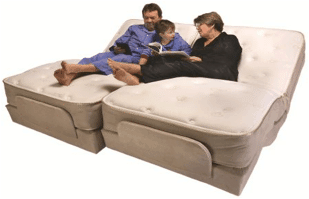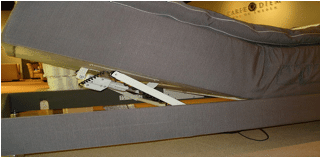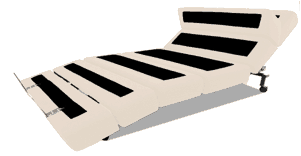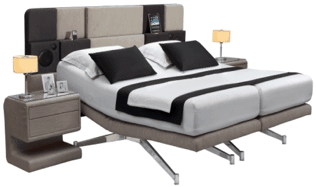BY MARY BEST
The adjustable bed category is gaining momentum as manufacturers continue to provide consumers new ways to get a good night’s sleep—and stay awake—in their beds.
The category’s increasing popularity—and sales potential—were evident at the summer Las Vegas Market where mattress manufacturers such as Trinity, N.C.–based Sealy set all but one of its redesigned Stearns & Foster models on adjustable bases and Kingsdown, with headquarters in Mebane, N.C., showed all of its new Blu–Tek specialty foam beds on adjustables. Other companies, such as Anatomic Global in Corona, Calif., rolled out entirely new adjustable programs.
Such merchandising drove home the point to dealers that showcasing mattresses on feature–laden adjustable bases is an ideal way to enhance consumers’ lifestyles—and increase retail tickets.
Brisk sales get brisker
Tempur–Pedic was one of the first major mattress brands to encourage consumers to pair its foam mattresses with Ergo adjustable bases—made by Reverie in Silver Creek, N.Y.—and recently has been promoting adjustables heavily with a multimedia advertising campaign.
The efforts have paid off. According to Mike Mason, director of brand development for the Lexington, Ky.–based company, the attachment rate for the Tempur–Pedic Ergo base was 19.4% in 2010 but had jumped to 28.6% by the middle of this year. Some dealers report selling 40% of their Tempur–Pedic mattresses with an adjustable base, Mason says.
Overall, Jimmy Grimes, senior group vice president of sales for power foundations at Leggett & Platt in Carthage, Mo., estimates that the adjustable foundation category has grown about 10% in the past five years but “in the past year or two,” he says, “it has been closer to 25%.”
Kelly Clenet, president of adjustable base supplier Ergomotion in Santa Barbara, Calif., agrees that growth in the category has been steady for the past five years, “but the most compounded growth has been in the past 18 months.”
Niles Cornelius, general manager of Hickory at Home, Hickory Springs Mfg. Co.’s direct–to–retail division in Hickory, N.C., has seen solid growth in the category industrywide and says Hickory at Home’s adjustables business specifically has grown between 25% and 50% during the past few years.
“We are on target to have 50% growth this year,” Cornelius says. “I think it will be more next year.”
These sales figures illustrate the shifting—and growing—position of the product category within the larger mattress industry.
“In the past couple of years, electric adjustable beds have gone from being a niche product to a product that is becoming mainstream among retailers and consumers,” says David Jaffe, president of Mantua Mfg. Co. in Walnut Hills, Ohio.

Prodigy by Leggett & Platt
This bed by Leggett & Platt brings together a comfortable sleep system and advanced technology, the Carthage, Mo.–based company says. It has an application that enables you to elevate your sleeping partner’s head 7 degrees to help stop him or her from snoring. A sleep timer allows you to sit up in bed and automatically be returned to a sleeping position after you’ve fallen asleep. A foot massage doubles as an alarm that wakes you up with light massage. iPhone and iPod Touch users can download an application to operate the bed and other electronics in the room. It has a suggested retail price of $1,800 in queen size. The mattress is sold separately.
With aesthetics in mind, Ergomotion’s 400 Series is designed to hide the adjustable feature so it resembles a modern bed. Sleek and lightweight, it can be placed inside any bed frame of a similar size and has removable stainless legs. A massage option has three levels of intensity and a timer. Head and foot sections adjust up to 60 degrees and a zero–gravity position is said to increase circulation and relieves pressure on your shoulders and lower back. The 400 Series, one of Santa Barbara, Calif.–based Ergomotion’s seven lines, retails for about $1,499 in queen size. The mattress is sold separately.
What’s driving growth?
Adjustables began as medical products and the contract market remains enormous. When the category moved into the consumer realm, many models retained their hospital–like feel. Today’s adjustables continue to be marketed as being able to alleviate medical conditions—from acid reflux to back problems—making them attractive to demographics like aging but active baby boomers.
But many adjustable bed makers have rebranded their products, replacing the stern medical detailing with more aesthetically pleasing, user–friendly details that appeal to consumers’ needs and sense of style. Motors are quieter; remotes wireless. High–end mattress fabrics coordinate with consumers’ bedroom decor and massage features ease muscles sore from a gym workout.
“The purpose of this product is to create a bedroom space that is a lifestyle and luxury choice. It may not be for any medical–based need but simply a decision based on comfort and functionality,” says Darren Nelson, sales and marketing director of Jin Ju Furniture, a manufacturer of adjustables with a facility near Shenzhen, China.
Young professionals in their 20s and 30s, who have discretionary income and a penchant for all things techie also have stimulated the market. With an appetite for an adjustable bed’s amenities—everything from those wireless remote controls to sound stations to iPhone and iPad docking stations—“they’re using beds as workstations for their computers,” Ted Singer, a director of sales for L&P, told The New York Times last year.
“Interest is driven by the fact that we all spend more time in bed now—that we use laptop computers, watch TV and some people still even read books,” Clenet says. “The mattress industry has now made this connection and has decided to incorporate ‘the lifestyle foundation’ into their newest programs.”
And if the price points are an indication, consumers are willing to pay for the luxury of the increased comfort and ability to multitask that adjustables offer. Not including the mattress, adjustable bases typically carry suggested retail price points between $499 and $1,999 in queen size. The most elaborate beds, usually sold with the mattress and in king size, can top out at $30,000.
Other factors have fueled the category’s growth, as well. Suppliers of adjustables that BedTimes spoke with pointed to the growing popularity among consumers of certain adjustable–friendly mattress constructions, although today, mattresses of virtually any construction can be designed to work with an adjustable foundation.
“The rise in memory foam, pocketed coil and latex mattresses has made electric adjustable beds more relevant to a greater number of consumers,” Jaffe says.
Many adjustable suppliers point specifically to foam bed maker Tempur–Pedic and its widespread TV and print campaigns and direct marketing efforts as sparking considerable interest in the category.
Price and shifting distribution channels have fueled further growth. Direct marketing, the Internet and lower manufacturing costs have made adjustables more widely available and affordable.
“As products continue to gain in popularity, the cost of making them tends to go down,” Jaffe says. “As prices trend downward over time, electric adjustable beds become more attainable to more consumers.”

Privia Customatic Adjustable Bedz
Privia Customatic Adjustable Bedz hopes to attract a wider consumer demographic for its adjustable beds—and it plans to do it with the Privia. The bed’s contemporary, modular base design is targeted toward consumers in their 20s and 30s, says the Phoenix–based company. The Privia includes adjustable head and foot sections with a wireless hand remote. A lumbar feature enables you to adjust the firmness in the lower back region and an LED nightlight helps you safely navigate a darkened bedroom. The Privia retails for $1,499 to $1,599 in queen size, mattress not included.

Flex-A-Bed Premier
Premier Hand–crafted and fully customizable, Flex–A–Bed’s Premier is built with quiet Linak motors that include an optional dual–timed massage. Resting on a foam foundation with an Advantech base, the mattress is treated with Bioguard to prevent bacterial growth, mold and mildew. Its innerspring construction is available in three levels of firmness. Mattresses also come in a low–profile version, memory foam, latex or a combination of innerspring and memory foam. The bed stands 23 inches tall and can be lowered to 21 inches by removing the casters. It also can be raised in 1–inch increments, from 2 to 7 inches, using optional leg extensions. Flex–A–Bed, based in LaFayette, Ga., touts the fact that the bed is made in the United States. It has a suggested retail price of $2,965 in queen, with mattress included.
Challenges remain
But even with recent growth in the category, challenges exist for the companies that produce adjustable bases and the mattress makers and retailers that sell them.
Chief among them: The need to re–educate those consumers who still perceive adjustables as products for an older, often infirm, demographic.
It’s been a tall order convincing the public that while adjustable beds can help alleviate certain health problems, they “are a lifestyle product that helps consumers enhance the time they spend in bed,” Jaffe says.
That re–education extends to retailers, too. Several adjustable producers told BedTimes that dispelling dealers’ reservations about the category’s profitability and appeal has been taxing.
Phil Sherman, managing member of Customatic Adjustable Bedz in Phoenix, says that, for many years, the adjustables market was fairly stagnant, with little innovation.
“With this mind–set instilled in many buyers, it has been challenging to demonstrate the enormous potential the category could produce,” Sherman says. “Today, buyers are seeing the marketing and sales potential the category offers. We are taking this to the next level.”
Avi Barssessat, president and chief executive officer of Hollandia International, a mattress and adjustable base producer in Sderot, Israel, puts it a bit more colorfully: “I visit with retailers and travel to their stores and I am sorry to tell you that 99% don’t want to add any changes to the product line. What I am trying to say to every retailer is this is the future. Start to sell today the product of tomorrow.”
Clenet offers this approach: “Once we have the mattress industry convinced that the flat foundation is the strange beast on the floor, our job is done. We will overcome this by producing better programs and continuing to tell the message that this lifestyle product is a great up–sell and takes no more real estate on the retail floor.”
Another concern, some adjustable producers say, is the threat of commoditization of the category.
“Imports have driven the price down real hard,” says Aaron Goldsmith, president of Transfer Master, a maker of adjustables based in Postville, Iowa. “To some degree, the Asian market has contributed to the idea that an adjustable bed might just be a commodity item, an alternative to box springs. That’s done a disservice to the segment because it takes away identity and features.”
“For domestic companies, the biggest challenge is imports,” agrees Ben Groce, controller of Flex–A–Bed, with headquarters in LaFayette, Ga.“But we are starting to see people slowly come back for domestic products because they’re looking for the quality.”
Others, like Jin Ju’s Nelson, see benefits of producing adjustables overseas. His company operates its own factory in China, allowing it to control quality. It manufactures product to be sold to wholesalers or distributors.
When possible, Cornelius creates a blended strategy. He sources some American–made adjustables and some from China, noting that some customers want to know a base was manufactured in the United States, while others are strictly price–driven.

Transfer Master Hi-Low
Original Hi–Low & Oasis: Though adjustables with furniture styling and consumer–friendly high–tech features are dominating retail showrooms, the category has its roots in the medical market—hospitals and home care still represent significant sales. While home–care beds are typically designed with the needs of home health care nurses in mind, the Original Hi–Low from Transfer Master is intended to accommodate the needs of the user and his family, as well. Standard features include head, foot and “Hi–Low” adjustable controls. The minimum height from the top of the hospital bed mattress to the floor is 18 inches and the Hi–Low mechanism enables the bed to be raised 12 inches. Complementing the Original is the Oasis, which is identical to the Original but without the Hi–Low function, according to the company, which is based in Postville, Iowa. A queen Original Hi–Low retails for $7,399, with mattress.

Carpe Diem Marstrand adjustable bed
Elegant Marstrand, a recent unveiling from Carpe Diem Beds, with headquarters in Lysekil, Sweden, is equipped with an electronic lumbar adjustment mechanism, which grants additional support when you elevate to an adjustable sitting position. The lumbar support and bed are operated by wireless remote control and most of the adjustability system is built into the main mattress. The top mattress has a cotton–filled side for summer sleeping and New Zealand wool–filled side for winter. It retails for $30,000 in a split king, with the mattress included.
From here
What’s ahead for adjustables?
“The next 10 years ought to become the prime time for adjustables,” Groce says.
Customatic Adjustable Bedz’s Sherman agrees: “The sales potential and growth of the industry is still in its infancy,” he says, comparing adjustables’ growth curve to that of memory and latex foam beds.
“Twenty years ago, you didn’t know what a memory foam bed was and today it’s a dominating force in the mattress business,” he says.
Jaffe hopes to see another 5% adjustable attachment rate to mattresses in 2012 and a 50% attachment rate in the next five years. Grimes forecasts adjustable base growth will average 25% or more annually over the next few years, with power foundations—L&P’s preferred term for the category—possibly accounting for 7% or more of the overall foundation market.
Baby boomers, one of the largest demographics, are expected to be the category’s main driver in coming years as they search for health and wellness products and have the discretionary income to spend.
“It may (help) overcome some of the gloomier prospects of what’s going on with Wall Street and the government’s fiscal policy,” Goldsmith says.
Perhaps the most critical and fundamental factor in the category’s growth in the next few years will be advances in the technology and design of adjustable bases, several suppliers told BedTimes. As the foundations gain acceptance, producers will continue to seek out more sophisticated features to offer.
Cornelius predicts the adjustable base could become a platform for companies to “do things they’ve always wanted to do.”
“The base becomes a platform for what you do in the future,” he says.

Hickory Springs Mfg. Co. Flexion 6
This month at the High Point Market, Hickory Springs Mfg. Co., based in Hickory, N.C., is presenting a new adjustable line called the Flexion Series, marketed under the iCare brand. The Flexion 6, one of the line’s four models, is made of an adjustable motion power base, a modern modular cushion/comfort deck support frame and six sections. Features include an accessory utility pocket, adjustable headboard brackets and a therapeutic dual body massage. Flexion 6 also has three pre–set memory positions. Retail prices, including mattress, for queen sizes range from $799 to $1,999.

Hollandia Platinum Luxe iCon
Platinum Luxe iCon: This is the world’s first bed designed to work with Apple’s iPad, says Hollandia International, a Sderot, Israel–based mattress manufacturer who markets the bed in collaboration with Princeton, N.J.–based Therapedic International. The sleep system–turned–entertainment center boasts an upholstered headboard with a quartet of 250–watt fully enclosed speakers and two built–in iPad and iPhone docking stations. The mattress is made of naturally ventilated Talalay latex and the Trio foundation is powered by three German–made motors. It’s available in hundreds of fabric and color combinations. It has a suggested retail price of $25,000 for a queen size, with mattress included.

Jin Ju Furniture Hi-Lo
The Hi–Lo adjustable bed by Jin Ju Furniture is designed to look like a standard mattress ensemble but offers hospital–bed amenities, such as head, foot and vertical lifts, according to the company, which has production facilities in Shenzhen, China. The frame design features a low–voltage, DC lift system and steel support. The Hi–Lo also includes complete bed height adjustment and an 8–inch latex mattress. It retails for $3,899 and $4,144 and is available in “long single” and “king single.”





